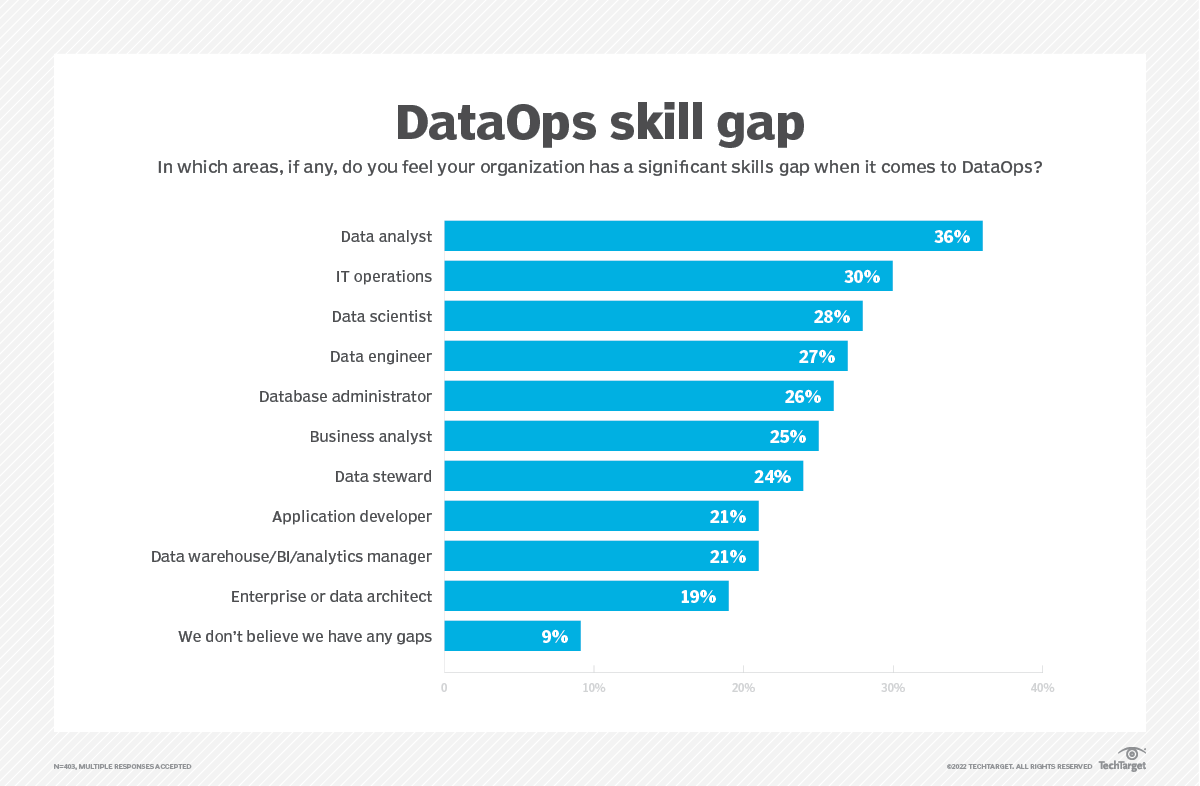Findings from a TechTarget’s Enterprise Strategy Group survey gauging the state of the ransomware preparedness market conclude that much work lies ahead for many organizations as they holistically address and resolve ransomware’s ongoing threat to disrupt IT and business operations. Though most organizations are at a relatively low level of ransomware preparedness maturity, a notable gap exists in attack prevention and data recovery between the companies most prepared and the industry average.
Data Management, Analytics & AI
-
-
The demand for rapid actionable analytical insights is forcing organizations to prioritize agility, transparency, and speed across their data ecosystems. These enterprises are investing in data-driven initiatives that maximize operational efficiency, improve collaboration, and accelerate time to value. They’re turning to DataOps.
-
Gone are the days when the data engineer was the key persona driving DataOps. IT operations, line-of-business leaders, developers, and end-users can all claim roles in the direction of their company’s DataOps initiatives. While this cross-functional team approach to DataOps is viewed as a positive trend, the ongoing technical skills gap in key DataOps positions continues to plague most organizations, overburden stakeholders, and compromise the value of DataOps initiatives.
-
Data quality issues, distributed data, tool proliferation, overburdened and underskilled teams, rising costs, and increased risk all contribute to the complexities of today’s data ecosystem that hinder the democratization of data and analytics. As a result, organizations are looking for ways to empower data teams to reliably deliver data and analytics to all consumers. DataOps processes liberate data silos and democratize workloads throughout the data lifecycle, yielding significant improvements in data quality, cross-functional collaboration, and analytics outcomes.
-
Ransomware attackers disrupt business operations by targeting a variety of data sources and leveraging multiple types of infrastructure to get what they want: business’ money. But the most often targeted point of entry in successful ransomware attacks is not a bad link in an infected email. Rather, the most vulnerable points of attack lie in the software and misconfigurations. Therefore, organizations must plan for every contingency, look beyond safeguarding the obvious vulnerabilities, and protect all components of their IT environment.
-
Despite global macroeconomic conditions, aggressive technology investments are expected to continue among more digitally transformed organizations. See highlights from research into these trends by TechTarget’s Enterprise Strategy Group with this infographic, 2023 Technology Spending Intentions.
-
Research Objectives
Based on a survey of 742 senior IT decision makers at midmarket and enterprise organizations, the 2023 Technology Spending Intentions Survey analyzes private and public sector technology spending expectations, the business and technology priorities driving those plans, and year-over-year trends in technology adoption and customer preferences. This year’s study from TechTarget’s Enterprise Strategy Group finds that enterprise technology spending will generally slow due to global macroeconomic conditions and the threat of a worldwide recession, but aggressive investments are expected to continue among more digitally transformed organizations.
For more information on this research, please visit www.esg-global.com/2023-technology-spending.
-
 IT leads the modern data platform, functioning as the conduit, efficiently delivering the correct data to the right users, to empower data-driven decision-making in organizations. Over the last decade, IT vendors have been trying to develop and offer solutions to address the flood of data that companies manage. A modern data platform tries to solve this problem. It’s a combination of interoperable, scalable and modular technologies, working together to deliver an enterprise’s overall data needs.
IT leads the modern data platform, functioning as the conduit, efficiently delivering the correct data to the right users, to empower data-driven decision-making in organizations. Over the last decade, IT vendors have been trying to develop and offer solutions to address the flood of data that companies manage. A modern data platform tries to solve this problem. It’s a combination of interoperable, scalable and modular technologies, working together to deliver an enterprise’s overall data needs. -
Research Objectives
Ascertain IT budget outlook for 2023 overall and for specific technologies.
Determine key business and technology priorities driving 2023 spending plans.
Establish a profile of digitally mature companies in terms of the technologies and processes underlying their IT strategies.
Monitor YoY trends with respect to technology adoption and changing customer preferences.
Already an Enterprise Strategy Group client? Log in to read the full report.
If you are not yet a Subscription Client but would like to learn more about accessing this report, please contact us.
-
 At Big Data London, data quality and intelligence took center stage as companies strive for fast and efficient delivery of quality information — and the vendors to make it happen. Big Data London is the U.K.’s leading data and analytics event, with more than 150 vendors, 300 expert speakers, and an estimated 10,000 attendees coming together to discuss data-driven strategies. During the event, I interviewed seven vendors to get their perspectives and insights on where the market was going, the challenges they saw, and more.
At Big Data London, data quality and intelligence took center stage as companies strive for fast and efficient delivery of quality information — and the vendors to make it happen. Big Data London is the U.K.’s leading data and analytics event, with more than 150 vendors, 300 expert speakers, and an estimated 10,000 attendees coming together to discuss data-driven strategies. During the event, I interviewed seven vendors to get their perspectives and insights on where the market was going, the challenges they saw, and more. -
 Data clean rooms are moving into the mainstream as privacy concerns complicate measuring ad ROI, but the “people problem” poses challenges to data operation success. Data clean rooms are becoming the preeminent tool for brands to better understand the place of digital marketing within the broader marketing ecosystem. In fact, data clean rooms are key for measuring advertising effectiveness, especially as advertisers are relying on cookies less, due to privacy regulations and big tech changes.
Data clean rooms are moving into the mainstream as privacy concerns complicate measuring ad ROI, but the “people problem” poses challenges to data operation success. Data clean rooms are becoming the preeminent tool for brands to better understand the place of digital marketing within the broader marketing ecosystem. In fact, data clean rooms are key for measuring advertising effectiveness, especially as advertisers are relying on cookies less, due to privacy regulations and big tech changes. -
 More than ever, increases in data-centric developer reliance, data sources, and users push developers to understand IT purchasing to provide more value to data. The days of creating data-generating systems for a single operational or analytics application are over. Because of this, developers must become more data-centric to increase business agility and empower data consumers — including internal teams, partners, and customers. Data-centric developers are expanding their sphere of influence on IT purchasing decisions and maximizing the value of data.
More than ever, increases in data-centric developer reliance, data sources, and users push developers to understand IT purchasing to provide more value to data. The days of creating data-generating systems for a single operational or analytics application are over. Because of this, developers must become more data-centric to increase business agility and empower data consumers — including internal teams, partners, and customers. Data-centric developers are expanding their sphere of influence on IT purchasing decisions and maximizing the value of data.

 IT leads the modern data platform, functioning as the conduit, efficiently delivering the correct data to the right users, to empower data-driven decision-making in organizations. Over the last decade, IT vendors have been trying to develop and offer solutions to address the flood of data that companies manage. A modern data platform tries to solve this problem. It’s a combination of interoperable, scalable and modular technologies, working together to deliver an enterprise’s overall data needs.
IT leads the modern data platform, functioning as the conduit, efficiently delivering the correct data to the right users, to empower data-driven decision-making in organizations. Over the last decade, IT vendors have been trying to develop and offer solutions to address the flood of data that companies manage. A modern data platform tries to solve this problem. It’s a combination of interoperable, scalable and modular technologies, working together to deliver an enterprise’s overall data needs. At Big Data London, data quality and intelligence took center stage as companies strive for fast and efficient delivery of quality information — and the vendors to make it happen. Big Data London is the U.K.’s leading data and analytics event, with more than 150 vendors, 300 expert speakers, and an estimated 10,000 attendees coming together to discuss data-driven strategies. During the event, I interviewed seven vendors to get their perspectives and insights on where the market was going, the challenges they saw, and more.
At Big Data London, data quality and intelligence took center stage as companies strive for fast and efficient delivery of quality information — and the vendors to make it happen. Big Data London is the U.K.’s leading data and analytics event, with more than 150 vendors, 300 expert speakers, and an estimated 10,000 attendees coming together to discuss data-driven strategies. During the event, I interviewed seven vendors to get their perspectives and insights on where the market was going, the challenges they saw, and more. Data clean rooms are moving into the mainstream as privacy concerns complicate measuring ad ROI, but the “people problem” poses challenges to data operation success. Data clean rooms are becoming the preeminent tool for brands to better understand the place of digital marketing within the broader marketing ecosystem. In fact, data clean rooms are key for measuring advertising effectiveness, especially as advertisers are relying on cookies less, due to privacy regulations and big tech changes.
Data clean rooms are moving into the mainstream as privacy concerns complicate measuring ad ROI, but the “people problem” poses challenges to data operation success. Data clean rooms are becoming the preeminent tool for brands to better understand the place of digital marketing within the broader marketing ecosystem. In fact, data clean rooms are key for measuring advertising effectiveness, especially as advertisers are relying on cookies less, due to privacy regulations and big tech changes. More than ever, increases in data-centric developer reliance, data sources, and users push developers to understand IT purchasing to provide more value to data. The days of creating data-generating systems for a single operational or analytics application are over. Because of this, developers must become more data-centric to increase business agility and empower data consumers — including internal teams, partners, and customers. Data-centric developers are expanding their sphere of influence on IT purchasing decisions and maximizing the value of data.
More than ever, increases in data-centric developer reliance, data sources, and users push developers to understand IT purchasing to provide more value to data. The days of creating data-generating systems for a single operational or analytics application are over. Because of this, developers must become more data-centric to increase business agility and empower data consumers — including internal teams, partners, and customers. Data-centric developers are expanding their sphere of influence on IT purchasing decisions and maximizing the value of data.